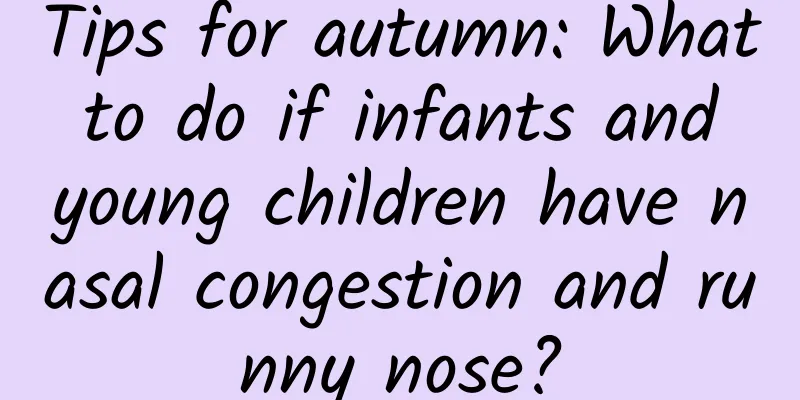Tips for autumn: What to do if infants and young children have nasal congestion and runny nose?

|
Nasal congestion and runny nose are common manifestations of diseases in infants and young children. Compared with adults, infants and young children have relatively narrow nasal cavities. Once mucosal edema occurs, the symptoms of nasal congestion and runny nose are more obvious. Nasal congestion and runny nose can be seen all year round, but in autumn, when the seasons change and the weather changes rapidly, there are more symptoms of nasal congestion and runny nose, mainly manifested as: stuffy nose, swollen nose, runny nose, etc. In babies, they often cry, have nasal snorting, have difficulty feeding, sleep restlessly at night, and even breathe with their mouths open, choke, and have a cyanotic complexion. What should parents do when faced with infants and young children who are uncomfortable with nasal congestion and runny nose? 1. Identify and avoid related causes The causes of nasal congestion and runny nose are: catching a cold, contact with animal fur, exposure to poor quality environments such as secondhand smoke, contact with allergens such as pollen for babies with allergic constitutions, family history of nasal diseases, nasal collisions or trauma, etc. You can make a rough judgment by asking and observing the child, combining previous illnesses, checking whether the child has other symptoms, and checking the nasal cavity. 2. Maintain a suitable environment Infants and young children's mucous membranes are mostly very sensitive to the environment, especially those with allergies. In addition to avoiding irritating gases such as cigarettes, infants and young children with allergies should also avoid environments that cause allergies. Therefore, the temperature and humidity of the environment where children live should change with climate changes. For example, in the relatively dry autumn and winter seasons, it is recommended that the indoor temperature be maintained at around 20-22℃ and the humidity be maintained between 50-60%. You can try to use a humidifier in the room or hang a wet towel or put a basin of water to increase the air humidity. If the baby's nasal cavity is blocked by secretions, you can gently massage the nose to promote the discharge of secretions; if the nasal crust is too dry, you can try to drip 1-2 drops of warm saline into the nasal cavity to moisten it, and then use a clean cotton swab to carefully roll out the secretions to avoid squeezing the nasal crust deeper into the nasal cavity. You can also use a household neti pot or nasal aspirator with warm saline, which is gentle and non-irritating. If the parents cannot clean it up, they can go to the hospital for nasal irrigation, which will be more effective. If your baby has a fever, rapid breathing, a cyanotic face, open mouth breathing, poor spirits, poor reaction, is always listless, refuses to eat, or has unexplained nose bleeding and other abnormal symptoms, it is recommended that you go to the hospital for medical treatment in time. 5. Tips to relieve nasal congestion and runny nose ① Hot compress and hot fumigation: Mothers can apply a hot towel to the baby's nose, or use hot steam to fumigate the nose, which can relieve nasal congestion, runny nose and other discomforts caused by cold, allergies and other reasons; ② Nose massage: Rub your palms together to warm them up, pinch both sides of the bridge of nose with the middle fingers of both hands at the same time, and push upward along the bridge of nose to the Shenting point quickly and forcefully, then push downward quickly to the side of the nose, up and down about 100 times; use the middle fingers to warm them up to massage the Yingxiang point, Bitong point and Yintang point for 1-3 minutes each; use the warm palms to massage the face and nose. ③ Take ginger, jujube and scallion water orally: This method is suitable for the early stages of cold or allergic symptoms, often accompanied by sneezing and clear runny nose. It can relieve symptoms of nasal congestion and runny nose. ④ External medications: Commonly used in clinical practice are: (1) Mucosal decongestants: such as furan nasal drops, but they can only be used for a short period of time, otherwise drug-dependent rhinitis is likely to occur; (2) Chinese patent medicines: such as Biyanning drops, compound hibiscus nasal ointment, paeonol ointment, etc. (3) Chinese medicine sachets: You can choose angelica dahurica, magnolia, mint, asarum, Xanthium sibiricum, soap bean, etc., grind them into a coarse powder, make them into sachets and place them next to your pillow or wear them on your chest. They can also play the role of aromatic orifices. (Wang Shuhuan, Department of Pediatrics, The First Affiliated Hospital of Henan University of Traditional Chinese Medicine) |
<<: Many people say it is a "hidden killer"! Seriously, everyone should be careful...
Recommend
This organ of women ages earlier than men
Many women develop osteoarthritis at an earlier a...
What to do if you have dry stool after abortion
Abortion is very harmful to women's bodies, b...
How many months of pregnancy should I do Down syndrome screening
There are time requirements for the Down syndrome...
Green discharge during pregnancy
Many women will have green discharge during pregn...
What is the best fertilizer for Clivia? What is the function of Clivia?
The flower language of Clivia is "noble"...
Can I drink monk fruit soaked in water during menstruation?
For ladies who pursue beauty, monk fruit is a goo...
What does carbohydrate antigen 153 mean?
Ca153 is the most important specific marker for b...
eMarketer: Social communication is becoming multi-platform, with email and social media at the top
Social media usage is on the rise among digitally...
Mole diagram of women's face
When it comes to moles, many people hope that the...
Dull abdominal pain 10 days before period
Most women have experienced dysmenorrhea, especia...
Is medical abortion better for women or surgical abortion?
How should women who are pregnant unexpectedly ha...
Can you get pregnant if you don't use a condom and don't ejaculate?
Modern people are more open-minded and start livi...
How do women use dumbbells to train their chest muscles?
Dumbbells are a very commonly used fitness equipm...
How can girls lose weight on the upper body
Many female friends have body disharmony problems...
How should pregnant women sleep in the last month?
Pregnant women should pay attention to their phys...









